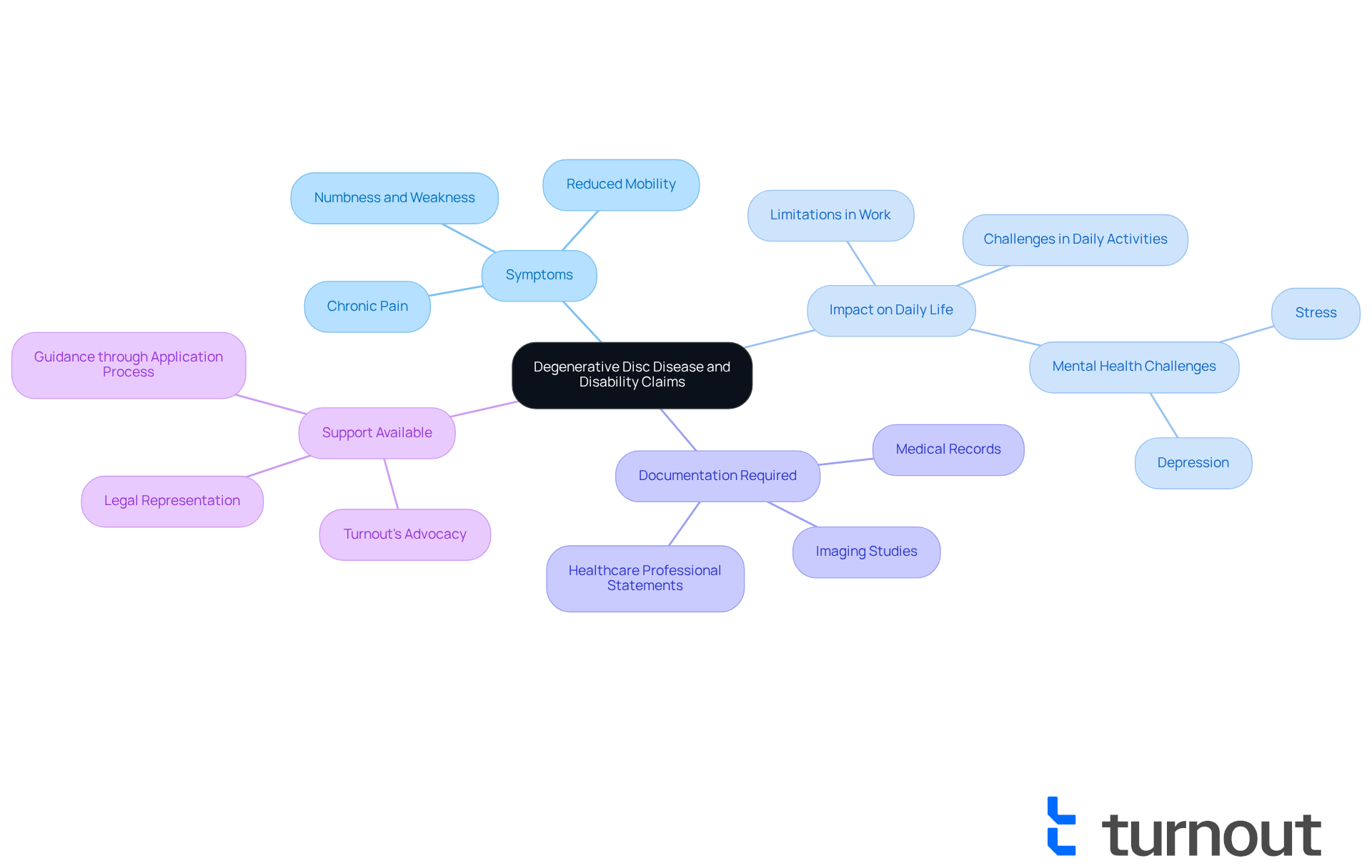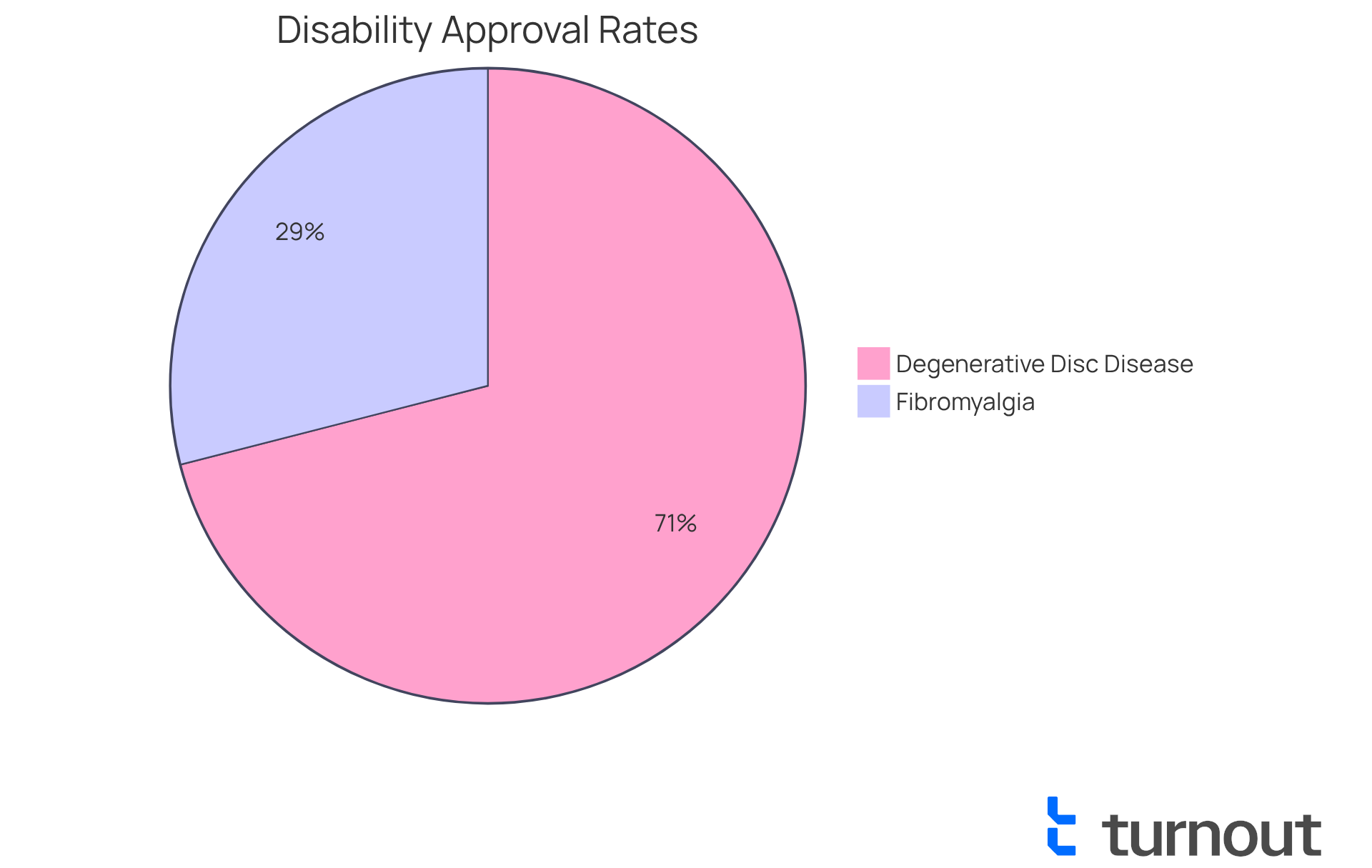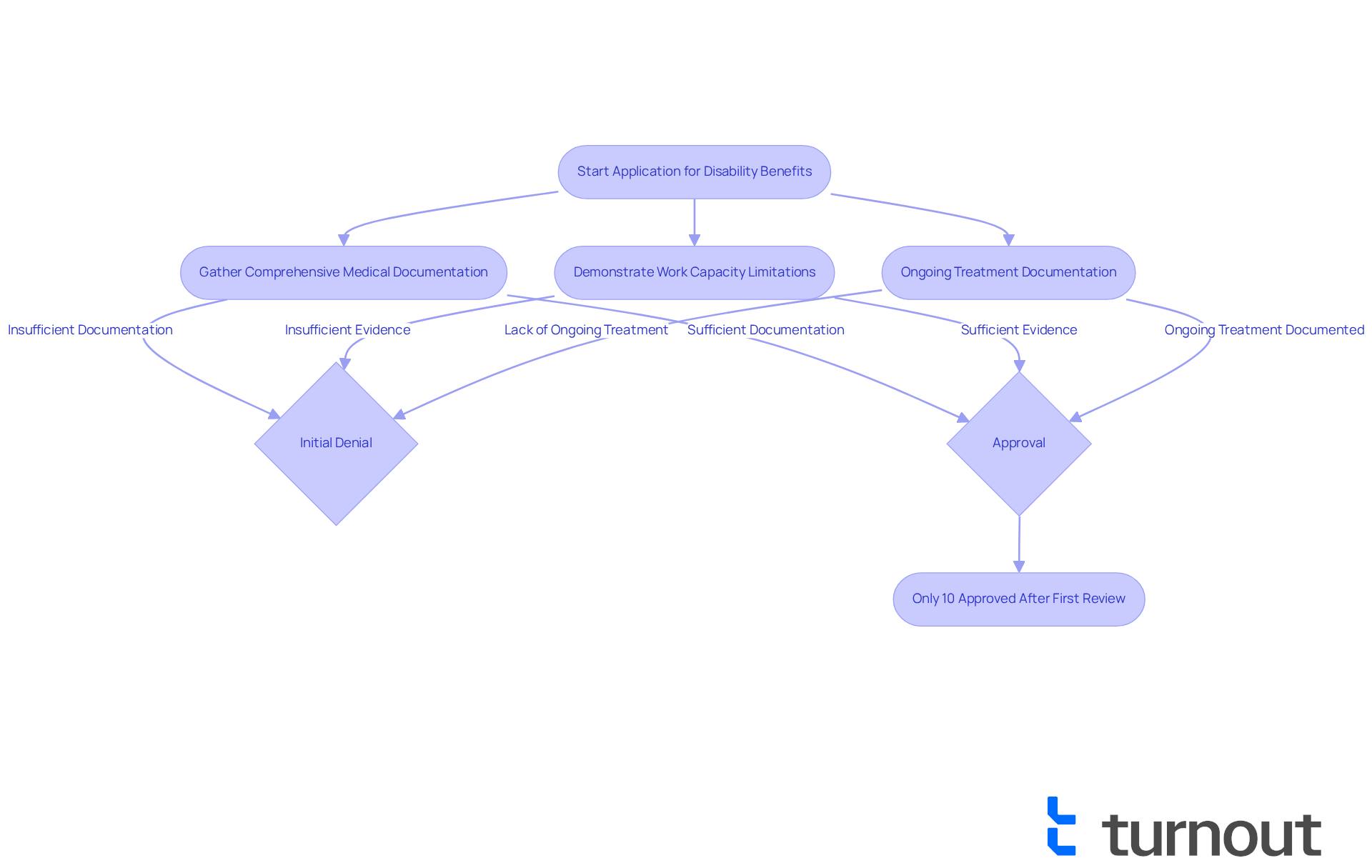Overview
Navigating the process of obtaining disability for degenerative disc disease (DDD) can be a daunting experience. We understand that the need for comprehensive medical documentation can feel overwhelming. This documentation must clearly demonstrate the severity of your condition and its impact on your daily life.
While the Social Security Administration recognizes DDD as a potentially disabling condition, many applicants face denials due to insufficient evidence. It's common to feel discouraged in this situation. Therefore, it’s crucial to gather thorough documentation and support throughout the application process.
Remember, you are not alone in this journey. We’re here to help you every step of the way. Taking action now can make a significant difference in your pursuit of the assistance you deserve.
Introduction
The struggle against degenerative disc disease (DDD) often extends beyond physical pain. It impacts daily life and the ability to work. We understand that for many, the question of how to secure disability benefits becomes a critical concern. The debilitating nature of DDD can severely limit one's functional capacity.
However, navigating the complexities of the Social Security Administration's (SSA) requirements poses significant challenges. It’s common to feel overwhelmed, leaving many applicants wondering about their chances of approval. What if there were strategies you could employ to effectively document your condition and enhance your likelihood of obtaining the assistance you need?
You are not alone in this journey. Together, we can explore ways to make this process more manageable.
Understanding Degenerative Disc Disease and Its Impact on Disability Claims
Degenerative disc disease (DDD) can be a challenging condition, involving the gradual deterioration of intervertebral discs. This often leads to chronic pain, reduced mobility, and significant limitations in physical activities. Many individuals affected by DDD report persistent back pain, numbness, and weakness in their limbs. These symptoms can severely hinder their ability to perform daily tasks and maintain employment. It’s not uncommon for those with severe DDD to consider how hard it is to get disability for degenerative disc disease as a vital support, as the condition can greatly affect their quality of life.
To successfully apply for disability benefits, it’s essential to demonstrate how hard it is to get disability for degenerative disc disease and how DDD symptoms impact your functional capacity. The Social Security Administration (SSA) acknowledges how hard it is to get disability for degenerative disc disease (DDD) as a potentially disabling issue. However, applicants must submit comprehensive medical documentation. This includes:
- Detailed medical records
- Imaging studies
- Statements from healthcare professionals that outline the severity of the condition and its effects on daily activities
We understand that the inability to work and perform daily activities due to DDD can lead to mental health challenges, including stress and depression. Many individuals experiencing chronic neck discomfort from cervical degenerative spinal issues often require frequent breaks due to pain or muscle fatigue. This can further hinder their work performance, making it even more difficult to cope.
Turnout is here to provide valuable support in navigating the SSD application process. They utilize trained non-professional advocates who can assist clients in gathering the necessary documentation and presenting their case effectively. It’s important to note that Turnout is not a law firm and does not provide legal representation. However, their advocates are well-equipped to support you through the complexities of the application process.
In conclusion, the impact of degenerative disc disease on your everyday life and work is significant. It requires a thoroughly documented strategy when seeking disability benefits. Successful requests often depend on your ability to clearly express how the situation restricts your capacity to engage in meaningful gainful activity, especially considering how hard it is to get disability for degenerative disc disease, backed by thorough medical evidence. With Turnout's guidance, you can better navigate the SSD claims process and seek the financial assistance you need. Remember, you are not alone in this journey.

Comparing Disability Qualification: Degenerative Disc Disease vs. Other Conditions
When assessing degenerative disc disease (DDD) against conditions like arthritis, fibromyalgia, or chronic fatigue syndrome, we understand how hard it is to get disability for degenerative disc disease while navigating the challenging qualifications. DDD may qualify under the SSA's listing for disorders of the spine, which requires evidence of nerve root compression or spinal stenosis. In contrast, fibromyalgia does not have a specific listing, making the assessment more subjective, focused on how symptoms impact daily life.
Documentation for DDD typically includes imaging studies that provide objective evidence, while other conditions often rely on self-reported symptoms. This distinction can significantly affect how hard it is to get disability for degenerative disc disease benefits.
Turnout is here to simplify your access to government benefits and financial assistance. We offer tools and services designed to help you manage the complexities of SSD requests. Statistics show that approval rates for disability applications concerning degenerative disc disease are generally higher than how hard it is to get disability for degenerative disc disease compared to those for fibromyalgia. While the SSA's allowance rate for DDD claims is around 71%, many wonder how hard is it to get disability for degenerative disc disease, especially since fibromyalgia claims often face a more challenging approval landscape, frequently falling below 50%.
This disparity highlights how hard it is to get disability for degenerative disc disease, emphasizing the importance of understanding the specific standards and documentation needed for each situation. With Turnout's expert guidance and resources, you can navigate these processes more effectively, improving your chances of approval. Remember, you are not alone in this journey; we are here to help.

Challenges in Securing Disability Benefits for Degenerative Disc Disease
It can be a daunting journey to understand how hard it is to get disability for degenerative disc disease. We understand that many face significant hurdles in this process. One of the biggest challenges is the need for comprehensive medical documentation that clearly illustrates the severity of your condition and its impact on your ability to work. Unfortunately, many applicants experience denials due to insufficient evidence or failure to meet the Social Security Administration's (SSA) stringent criteria. The personal aspect of pain and functional restrictions can make it difficult for decision-makers to fully grasp the debilitating effects of DDD. For instance, Joyce Pridgett's case took three years to resolve, highlighting the lengthy nature of the appeals process, which often requires additional documentation and support.
Turnout is here to help you navigate these complexities. While not a law firm, Turnout employs trained nonlawyer advocates who can assist you in understanding the SSD claims process and gathering the necessary documentation. Common reasons for denial include:
- Inadequate medical evidence
- Failure to demonstrate that the condition significantly limits your work capacity
- Insufficient documentation of ongoing treatment
It's important to note that only 10% of applicants are found disabled after an initial review because they meet or medically equal a musculoskeletal disorders listing. The SSA's evaluation process is rigorous; 90% of allowances for musculoskeletal impairments occur at step 5, where your residual functional capacity is assessed.
You must be prepared to navigate these challenges. This may involve gathering extensive medical records, obtaining statements from healthcare providers, and potentially appealing initial denials. Understanding how hard it is to get disability for degenerative disc disease is crucial for anyone considering applying for disability benefits, particularly with the updated SSA listing under listing 1.15. Remember, you are not alone in this journey, and we’re here to help you every step of the way.

Conclusion
Understanding the complexities surrounding disability claims for degenerative disc disease (DDD) is essential for those affected by this debilitating condition. We recognize that the journey to securing disability benefits can be fraught with challenges. However, by recognizing the requirements and the importance of thorough documentation, you can significantly enhance your chances of approval. By grasping how DDD impacts daily life and work capabilities, you can better articulate your needs in the application process.
Throughout this article, we shared key insights regarding the nature of DDD, the essential documentation required for successful claims, and the comparative approval rates against other conditions like fibromyalgia. It is important to note that while DDD may qualify under specific SSA listings, the need for comprehensive medical evidence remains paramount. We also highlighted the role of advocates, such as Turnout, in helping applicants navigate the complexities of the SSD claims process, ensuring that you are not alone in your pursuit of financial assistance.
Ultimately, the significance of understanding how hard it is to get disability for degenerative disc disease cannot be overstated. You deserve to feel empowered to seek the support you need and take proactive steps in your applications. By gathering the necessary documentation and seeking guidance, you can improve your chances of overcoming the hurdles that often accompany disability claims. This journey is one of resilience, and with the right resources, a successful outcome is within reach.
Frequently Asked Questions
What is degenerative disc disease (DDD)?
Degenerative disc disease (DDD) is a condition characterized by the gradual deterioration of intervertebral discs, which can lead to chronic pain, reduced mobility, and significant limitations in physical activities.
What symptoms are commonly associated with DDD?
Common symptoms of DDD include persistent back pain, numbness, and weakness in the limbs, which can severely hinder daily tasks and employment.
How does DDD impact an individual's quality of life?
DDD can greatly affect an individual's quality of life by causing chronic pain and limitations in physical activities, which may lead to challenges in maintaining employment and performing daily tasks.
How can individuals apply for disability benefits due to DDD?
To apply for disability benefits due to DDD, individuals must demonstrate how the condition impacts their functional capacity and submit comprehensive medical documentation, including detailed medical records, imaging studies, and statements from healthcare professionals.
What role does the Social Security Administration (SSA) play in disability claims for DDD?
The SSA acknowledges DDD as a potentially disabling issue, but applicants must provide thorough medical evidence to support their claims for disability benefits.
How can DDD lead to mental health challenges?
The inability to work and perform daily activities due to DDD can lead to mental health challenges, including stress and depression, especially for those experiencing chronic discomfort.
What assistance does Turnout provide for disability claims related to DDD?
Turnout offers support in navigating the SSD application process through trained non-professional advocates who help clients gather necessary documentation and present their cases effectively.
Is Turnout a law firm?
No, Turnout is not a law firm and does not provide legal representation; however, their advocates are equipped to assist clients through the application process.
What is essential for a successful disability claim for DDD?
A successful disability claim for DDD often depends on the applicant's ability to clearly express how the condition restricts their capacity for gainful activity, supported by thorough medical evidence.




